How much do Hollywood campaigns for an Oscar cost?
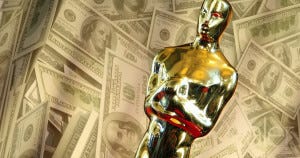
On Thursday, the Oscar nominations will be revealed. Although for the public this is the start of 'Oscar season', in fact the studios have been campaigning hard for many months.
Millions of dollars have already been spent and by the time Oscar night comes around on 22nd February, Hollywood will have spent over $100 million to win a little golden man.
Most of the reporting online is about the films, the frocks and the politics - little about the financial cost. So I did a bit of digging and have put together the numbers behind Oscar campaigns.
In summary...
Oscar voters are 94% white, 77% male and have a median age of 62.
56% of 'Best Picture' nominees were released in either November or December.
The cost of a 'Best Picture' winning Oscar campaign is around $10 million
Half of all the money spent on Oscar campaigns will go on advertising
A page 1 advert in The Hollywood Reporter during Oscar season costs $72,000.
Crash (2005) spent $250,000 on DVD screeners
PR consultants are paid $10k-$15k, plus bonuses of $20k per nomination / win.
It costs around $3,500 to prepare a Hollywood actress for the red carpet
Oscar nominated films earn average of $12.7m more than films not nominated
A 'Best Picture' Oscar win is worth $3 million in increased box office gross
A Golden Globe win is worth $14.2 million
The non-financial benefits to studios of an Oscar ‘Best Picture’ are worth $7m
Best Actor winners can expect a $3.9m salary increase
It's just $500k for Best Actress winners
It is possible to predict the Oscar winners with a success rate of 77% for Picture, 93% for Director, 77% for Actor, and 77% for Actress
What are the Oscars and who gets to vote?
The Oscars are the annual awards given out by the Academy of Motion Picture Arts and Sciences. The Academy Awards began in 1929, and by 1934 they were already being called 'the Oscars'. The moniker's origin is disputed, coming either from Walt Disney, Bette Davis' husband or from the Academy's Executive Secretary commenting that the statuette looked like her Uncle Oscar. In 2013 their official name was changed to "The Oscars".
There are 6,028 voting members of the Academy and a 2012 study found that they are mostly male, largely white with a median age of 62.
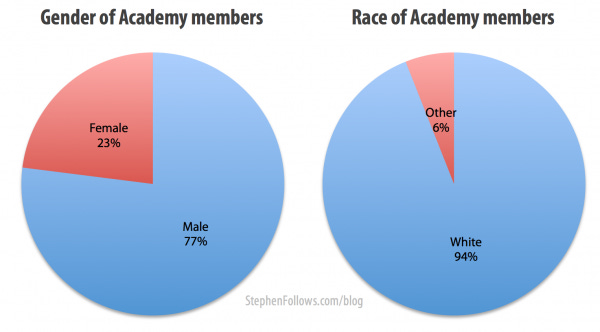
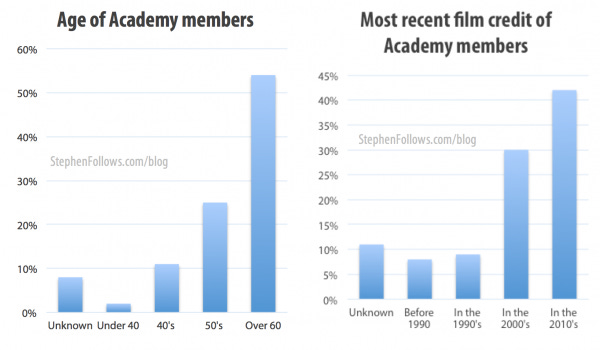
They accept applications for new members once a year in March and last year 271 new members were added to the roster.
How does the voting work?

The voting system for the Oscars seems to reflect Hollywood more generally - i.e. it is unnecessarily complex and somewhat stuck in the past. The system has changed little in the past 80 years, even to the extent that it's still managed by the same accountancy firm, PriceWaterhouseCooper.
In 2012, the ability to vote online was added, although in 2013 half of voters still used the paper system. The system for picking 'Best Picture' is thus...
Academy voters rank the nominees from one to ten (or to nine, if nine are in the running like last year)
Initially, the ballots will be sorted into piles according to which film each voter ranked No. 1.
Then, the movie with the smallest pile (that is, the movie with the fewest first-place votes) will be eliminated.
The ballots from that smallest pile are then redistributed based on the films they have ranked in second.
Then, with eight films remaining, if no one film has captured a majority of votes, the process is repeated and the smallest remaining pile is redistributed until one film has a majority.
This system means that it is often the second and third choices of voters which are the determining factor. One recent exception was The King’s Speech which received over 50% of total votes in the first ballot. However, the battle between two films like Gravity and 12 Years a Slave could easily have been determined by those who rated outsiders like Her or Nebraska as their first choice.
What do the studios do to influence voters?
Any and everything! This includes...
Showing the film - In screenings, on preview DVDs and via private VOD.
Advertising - In trade publications, billboards and industry websites.
Direct marketing - Via materials sent to Academy members directly
PR and lobbying - Key talent attend award ceremonies leading up to the Oscars and highly paid lobbyists feed the popular press and smear rival films.
Moving the film's public release date - See below.
Even casual cinema-goers will have noticed that Oscar-friendly films tend to come out late in the year. This strategic releasing means that Academy voters are more likely to see the films as 'fresh' as they are still being featured in the popular press when they're casting their votes. I wanted to check the numbers behind this so I took a look at the 97 films nominated at the Oscars held between 2000 and 2013.
It turns out that 56% of films nominated for 'Best Picture' at the Academy Awards between 2000 and 2014 were first released in the US in either November or December.
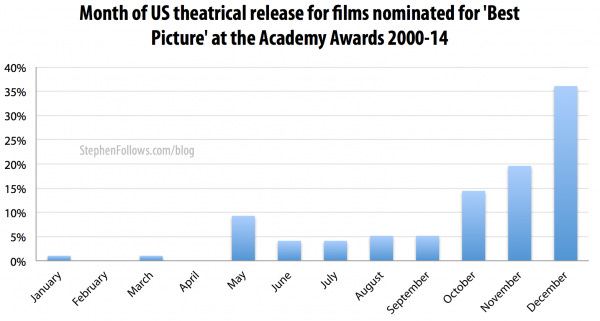
How much does an Oscar cost?
Estimates for the total amount Hollywood spends on Oscar campaigns each year range from $100m up to $500m. True figures are hard to come by so it's tricky to know what's true and what is carefully placed rumours by Hollywood friends, enemies and frenemies.
[table id=48 /]
In 2002, the New York Times reported that "the most aggressive studios have mounted campaigns that by some estimates have already cost more than $10 million, easily double what a successful effort totalled only two years ago". That's twice the average cost of winning a seat in Congress. Many non-studio films find themselves priced out of the running.
How are those $ millions spent?
Below are breakdowns of the Oscar costs of four Oscar-nominated films. Part of the conditions attached to publishing the data include that I cannot reveal the names of the films. However, I can tell you the following...
Film One is a 2014 'Best Picture' nominee
Film Two is a 2014 'Best Picture' nominee
Film Three is a 2013 'Best Picture' nominee
Film Four is a 2011 'Best Picture' nominee
Across these four films, 53% went on advertising, 12% on screeners and 35% on other costs. Obviously, we can’t know how representative these films are of all Hollywood campaigns but the evidence I have suggest that they are a good guide.
How are the campaigns structured?
The studios budget for their Oscar campaigns are in two phases...
Phase One - Getting nominated
Phase Two - Winning awards
The exact split of costs between the phases varies per film, but overall it seems to be roughly 56% of the total Oscar cost being spent in phase one and 44% in phase two. However, the costs are not split equally. Almost all of the money spent on screeners are paid for in phase one, with next to no screeners being sent out in phase two. Talent-related costs increase greatly in phase two, due to appearances at awards and events during the final voting period. Below is the breakdown of costs for my 'Film Two'.
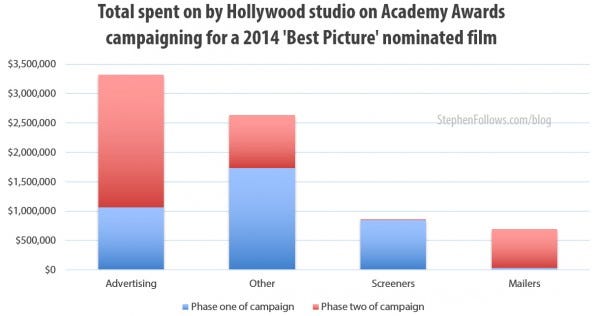
A breakdown of the Oscar costs
Advertising and Media costs are the two largest single costs followed by talent related costs and publicists. Those four cost categories alone account for around two-thirds of Oscar costs.
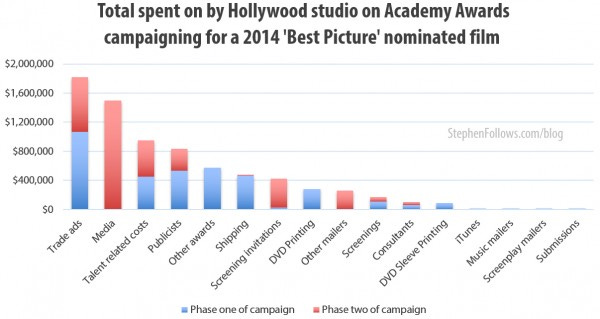
Advertising
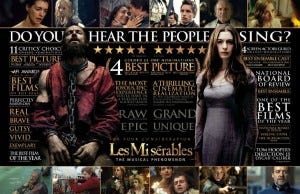
During Oscar season, the studios aggressively pay for adverts politely reminding Academy voters of their films. Often under the phrase 'For your consideration', these adverts appear in almost every area of the film industry; online, in print, on billboards and even videos.
A page 1 advert in The Hollywood Reporter during Oscar season cost one Best Picture nominee $72,000.
Screeners

Screeners are preview DVD copies of the films, sent to every voting member of the Academy. The total cost for sending out DVD screeners to all members of the Academy for Crash was $250,000, a move generally regarded to have played a major part in its 2005 Best Picture win. One 2014 nominee mailed out 54,000 screeners, at a cost of $290,000.
Digital copies are also sent out via iTunes. By comparison, these are a lot cheaper, costing the same film just $12,000 (the majority of which was a SAG coordination fee).
Screeners are routinely pirated online, and this year is no exception. Andy Baio does a sterling job at tracking screener piracy among Oscar-nominated films.
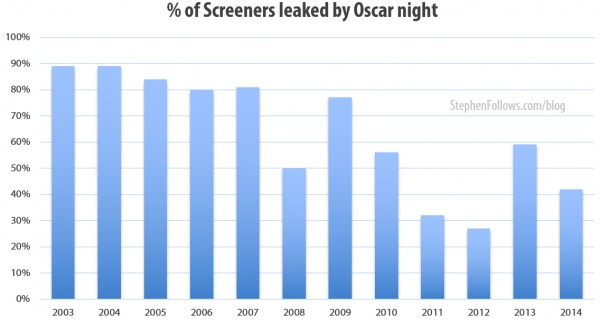
However, the percentage of nominated films which have pirated screeners online by Oscar night has fallen in recent years. This could be due to a number of factors, including increased security measures and reduced time between the theatrical release and the DVD being on sale to the public (thereby reducing the need for pre-release screeners).
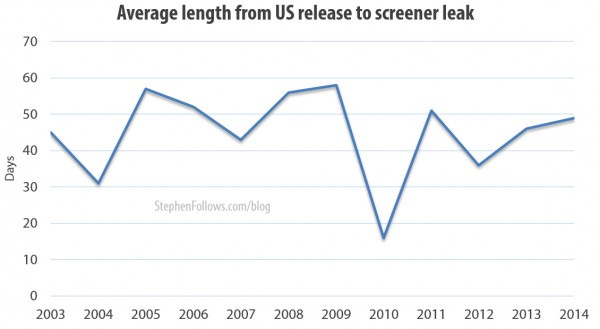
Screenings
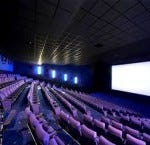
As well as DVD screeners, Academy voters are given the chance to see the films at private screenings. Once the nominations have been announced, Academy rules permit just two official screenings meaning that studios spend far more on pre-nomination screenings than post-nomination screenings. Total screening costs are, on average, around $100,000 in phase one and $60,000 for phase two.
Academy Consultants
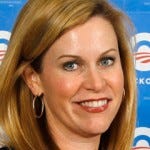
All of this spending is co-ordinated by Academy PR consultants. In many cases, studios will engage the services of more than one consultant for each film, and many Academy consultants seem to work on a number of films concurrently. In 2013, Harvey Weinstein hired Stephanie Cutter, President Obama’s former Deputy Campaign Manager to promote Silver Linings Playbook. On average, consultants are paid $10,000 - $15,000 per film, plus bonuses. These bonuses can really add up; from data I've seen on recent films these included...
$20,000 for a 'Best Picture' nomination
$20,000 for a 'Best Picture' win
$10,000 for nominations for best actor, best actress and best director
$10,000 for wins for best actor, best actress and best director
$5,000 for nominations in other categories, with $10,000 for a nomination and a win (best supporting actor,best supporting actress and cinematographer are occasionally worth more).
Other awards ceremonies

Leading up to the Oscars there are a host of smaller awards ceremonies, including the BAFTAs and the Golden Globes, which present a perfect chance for studios to show their film as the presumptive Oscar winner. This means that the cost of these events are included in Oscar campaign budgets. These include...
Hotels
Travel
Talent grooming
Buying tickets to attend awards
Other talent-related costs
The costs of the Golden Globes campaigns seem to be around 5% of the Oscar cost.
What do attending the Oscars cost?

Once the big night rolls around the costs don't end. Your stars need to be groomed, transported and ushered every step of the way. Grooming can set studios back upwards of $2,000 per night for an actor and $3,500 per night for an actress. Transportation quickly adds up, with planes and cars taking up most of the costs. One studio spent $30,000 on transportation for one film alone. A studio with a Best Picture nominee can expect to spend around $100,000 for on-the-night costs. This is on top of the $50,000 which they will have spent on the Nominees Luncheon a few weeks prior.
Terms and Conditions apply (but are ignored)
The Academy issue a 21-page rulebook, which all participants are expected to follow. That said, it seems that the rules are there to be broken. Smear campaigns are common, many credited to Harvey Weinstein, although even Hollywood royalty like Meryl Streep are not above it.

One person who fell foul of Oscar rules is Nicolas Chartier, producer of the 2010 Oscar-winning film The Hurt Locker. He wrote an email to Oscar voters asking them to vote for his film, not "a $500 million film" (i.e. Avatar).
His email included the line "we need independent movies to win like the movies you and I do". The Academy took action and Nicolas was banned from attending the ceremony.
New rules in 2012 placed limits on the number of events which studios are allowed to host in order to influence Academy voters. The rules state that other than two official Academy screenings, no member "may be invited to or attend any event, including breakfasts, lunches, dinners, parties and receptions, that in any way promotes or honors a nominated film, a nominee, or is attended by a nominee or anyone with a direct association with a nominated film”.
Is it worth it for the studios?

The films that win Oscars are often made on smaller-than-average budgets (by Hollywood standards, at least) and tend to perform very well at the box office. A 2001 study by Department of Economics at Colby College concluded that films nominated for 'Best Picture' earned an average of $12.7 million more than those that were not. However, it doesn't naturally follow that the million-dollar Oscar campaign spends are worthwhile - correlation is not causation.
It seems silly to point this out but the vast majority of films nominated for Oscars are the among the best films of the year. This could mean that the higher box office figures are down to the actual film, not the award nominations and wins.
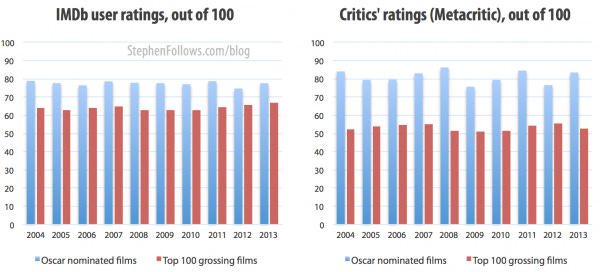
So to answer this question we need to turn to the work of a statistician called Edmund Helmer, who has performed some interesting analysis in 2011 into the value of an Oscar on box office receipts (a smaller, updated version is also here). He concluded that the Golden Globes represent much better value to the studio than the Oscars. He valued a Golden Globe win at $14.2 million, compared with $3 million for an Oscar.
So when you compare his 'value' of $3 million for a win with the average Oscar cost of $10 million for the campaign, there doesn't seem to be a clear financial reason for Oscar campaigns.
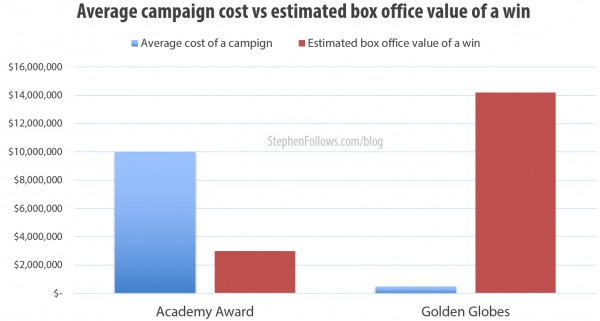
So while it may not make pure economic sense to campaign hard for an Oscar there are clearly other benefits, including Hollywood politics, bragging rights and brand image. Using the numbers above, we can value this 'image' enhancement at around $7 million per 'Best Picture' win.
Does it help an actor's career to win an Oscar?
Yes, but not by as much as you'd think. It can take a few years to be able to fully capitalise on an Oscar win and the buzz normally fades within three years. There is evidence to show that male actors benefit more than female actresses from an Oscar win.
The average salary increase for actors winning Best Actor is $3.9 million, whereas it's just $500,000 for a Best Actress win.

Reese Witherspoon is an oft quoted example of someone for whom an Oscar has little advantage. At one point she was one of Hollywood's best paid stars but by the time she won her first Best Actress award in 2006 (for Walk The Line) her star was already beginning to fade. The award appears to have had little to no positive effect on her career and it's only been her recent efforts as a producer which have helped her regain her power in Hollywood.
How predictable are the Oscars?
It seems that no article about the Academy Awards is complete without a few predictions. Statistician Iain Pardoe at the University of Oregon writes the most convincingly on the topic, including articles for the American Statistical Society and in the Journal of the Royal Statistical Society
According to Iain "Discrete choice modeling of past data on Oscar nominees in the four major categories—Best Picture, Director, Actor, and Actress—enables prediction of the winners in these categories with a reasonable degree of success. If recent trends persist, it should be possible to predict future winners with a prediction success rate of approximately 77% for Picture, 93% for Director, 77% for Actor, and 77% for Actress". So here's a primer in the art of 'Best Picture' Oscar prediction...
Number of Nominations: “Total number of Oscar nominations [1938–2004]. Nominees for Best Picture are often also represented by multiple nominees in other categories, and the chances of winning are generally thought to increase the higher the total number of nominations. For example, the median number of nominations for winners of the Best Picture Oscar since its inception (1928–2004) is nine, whereas the median number of nominations for losing Best Picture nominees is six.”
Best Director: “Only three movies have won the Best Picture Oscar without also receiving a Best Director nomination (Wings in 1928, Grand Hotel in 1932, and Driving Miss Daisy in 1989)” [Note - Since Iain wrote this, Argo should be added to the list ]
Golden Globes: “[Out of] 62 Best Picture Oscar winners from 1943 to 2004, 34 had won a Golden Globe for Best Picture (Drama) a few weeks earlier. Of the 54 Best Picture Oscar winners from 1951 to 2004, ten had won a Golden Globe for Best Picture (Musical or Comedy) a few weeks earlier"
DGA’s and PGA’s: “Of the 40 Best Picture Oscar winners from 1949 to 1988, 31 had already won a DGA award (and two would subsequently win one). Of the 16 Best Picture Oscar winners from 1989 to 2004, ten had already won a PGA award (and one would subsequently win one)”
Omer M. Mozaffar wrote eloquently on the topic of Oscar predictions. His advice includes the following...
Best actress - “The Academy Award winner for Best Actress always goes to a performance for whom gender and/or sexuality is a major part of the character's story. If you remove the sexuality aspect or the importance given to gender in the character's narrative, then you will fundamentally change the character.”
Best Actor - “The Academy Award for Best Actor will go to a performance about a man who is pushing against a very difficult, un-accepting, maddening world. That man has some trait that makes him a square peg in the circle of society.”
Best Picture - “The biggest category might overtly seem to be the most American. The Academy Award Best Picture is, generally speaking, a liberation story. The Oscar goes to a film that involves someone in some sort of prison, seeking and achieving some sort of freedom, though death often takes place in the process (along with some sort of love interest, usually)."
Epilogue
Today's article is a little longer than my normal fare, mostly because the topic is so rich. I'm grateful to Alexis for helping and to Sophie for proofing. Without you both I'd have less to say and would say it badly. This research includes data from some sources who wish to remain nameless but who are deeply involved in the Academy race. I'm grateful to them for their trust, candour and the raw data. Thanks to them, I am able to share data never before published about the true Oscar cost.


